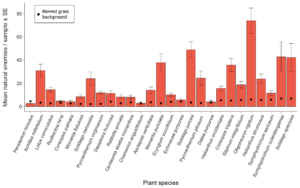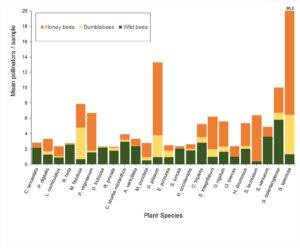2016 Annual Report for LNC14-361
Insectary Plants to Enhance Beneficial Insects: Expanding the Palette to Increase Options for Sustainable Crop Production in the NC Region
Summary
The goal of this project is to conduct research and education to increase the availability of insectary plants to enhance beneficial insects in the North-Central Region. In 2015-2016, we conducted weekly sampling of natural enemy and pollinator abundance on 54 species of plants in three common-garden research sites located at: 1) Southwest Michigan Research and Extension Center (SWMREC), 2) the Clarksville Research Center (CRC), and 3) Northwest Michigan Horticultural Research Center (NWMHRC). 2015 samples have been sorted and insects identified while 2016 samples are still being processed. Our 2015 results show 25 to 27 species of plants that are significantly more attractive to natural enemies and pollinators than control plots. Our 2015 results were shared with a variety of scientific and lay audiences via field days, research talks, and poster presentations at grower meetings and land stewardship conferences. Over 120 people attended our project-specific field day in July 2016.
Objectives/Performance Targets
2016 Objectives:
- Sample plants for natural enemy and pollinator abundance and plant traits at all three locations
- Host field days to inform stakeholders about the project and preliminary results
- Redesign of website to incorporate 2015-2016 data
Accomplishments/Milestones
In 2016, we conducted our second year of data collection at three common-garden research plots in Michigan where 54 species of potential insectary plants had been established in 2014. Plants were sampled weekly while in bloom to assess plant traits including; height, percent cover, and floral area. Pollinators and natural enemies were sampled to determine the relative attractiveness of plant species compared to control plots. A total of 54 species bloomed in 2016 and sampling occurred from May through October. Plant species differed in their attractiveness, with 27 species significantly more attractive to natural enemies than their corresponding controls at one or more of our common garden sites (Figure 1). The top 25 most attractive plants to pollinators supported a diversity of honeybees, bumblebees and wild bee pollinators (Figure 2).
We have shared our first year (2015) results in a variety of ways, including presentations at scientific meetings, presentations at land stewardship meetings, presentations at grower extension meetings, and via a project-specific field day held on August 2 at the Clarksville Research Center. Our project field day attracted over 120 participants including farmers, native plant enthusiasts, and agricultural educators. We also continue to expand the resources available at our project website nativeplants.msu.edu. During 2016, the website was visited 82,400 times by 71,400 users. This is an increase of 20% more visits than in 2015. Working with our college technology team, we have designed and programmed a native plant selection tool for those interested in choosing plants most attractive for beneficial insects based on our research. This tool will identify plants most likely to grow successfully at the user’s site. During the next few months, we are loading the tool with information and images.
Ongoing activities include processing and analysis of 2016 data, writing of scientific papers and Extension bulletin development. The two graduate students on this project (Gibson and Rowe) will both be completing their degrees in spring-summer 2017.
Figure 1. Mean natural enemy abundance on plant species averaged across three sites in Michigan (SWMREC, CRC, NWMHRC) in 2015. Error bars indicate standard error of the total natural enemies. Black dots indicate mean natural enemy abundance on mowed grass background during bloom time of each species. Plant species are arranged according to mean time of full bloom across the sites. Only species for which mean natural enemy attractiveness was significantly greater than the mowed background (one-tailed Welch’s T-test, p < 0.05) at a minimum of one individual site are shown. The remaining 23/50 species which bloomed in 2015 never attracted significantly more natural enemies than the mowed grass background.
Figure 2. Mean pollinator abundance of honey bees, bumblebees, and wild bees on the top 25 plant species averaged across three sites in Michigan (SWMREC, CRC, NWMHRC) in 2015. Plant species are arranged according to mean bloom time of full bloom across the sites.
Impacts and Contributions/Outcomes
Field Days
Assessing Insectary Plants for Beneficial Insects: 2015 CRC Results. DA Landis, R Isaacs, L Rowe, D Gibson, J Perrone. Clarksville Research Center Field Day. June 22, 2016
Supporting Beneficial Insects with Flowering Plants. DA Landis, R Isaacs, L Rowe, D Gibson, J Perrone. Project-specific field day held on August 2, 2016 at the Clarksville Research Center.
Insectary Plants to Enhance Beneficial Insects. DR Gibson, L Rowe, M Bolt. Northwest Michigan Horticultural Research Center Open House. August 25, 2016.
Presentations (presenter name in bold)
Integrating agriculture and prairie restoration: native wildflowers to support natural enemies of crop pests. DR Gibson, L Rowe, J Perrone, R Isaacs, and DA Landis. Stewardship Network Science Practice & Art of Restoring Native Ecosystems. East Lansing, MI. January 13-14, 2016. Poster.
Evaluation of Michigan native plants and ‘bee keeper picks’ for pollinators in Michigan. Logan Rowe, Rufus Isaacs, Daniel Gibson, Julia Perrone and Doug Landis. The Science, Practice, and Art of Restoring Native Ecosystems East Lansing, MI, January 13-14th, 2016. (poster)
Native perennial plants to attract natural enemies. DR Gibson, DA Landis. International Congress of Entomology. Orlando, FL. September 25-30, 2016.
Identifying Native Plants to Support Pollinators in Michigan. Logan Rowe, Rufus Isaacs, Michael Killewald, Daniel Gibson, Douglas Landis. International Congress of Entomology. Orlando, FL, September 25th, 2016. (poster)
The Importance of Pollinators and Plants to Support Them. Logan Rowe. Keenagers group. Haslett, MI. August 15th, 2016 (outreach talk)
Habitat for Pollinators: Current Efforts in Conservation and Restoration. Logan Rowe Michigan Society of American Foresters 2016 Conference. Gaylord, MI. October 6-7, 2016 (outreach talk)
Collaborators:
Professor and Extension Specialist
Michigan State University Department of Entomology
Center for Integrated Plant Systems Lab
578 Wilson Rd., Room 202
East Lansing, MI 48824
Office Phone: 5173556619
Website: http://www.isaacslab.ent.msu.edu/Home.html
Senior Academic Specialist
Michigan State University IPM
Food Safety and Toxicology
1129 Farm Lane, Room B18
East Lansing, MI 48824
Office Phone: 5173534951

